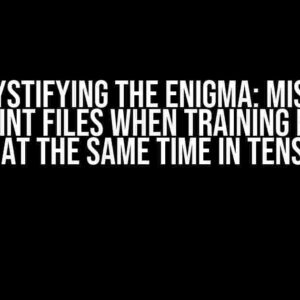Are you tired of complex machine learning algorithms that leave you scratching your head? Look no further! Linear Regression Using Normal Equation with @ symbol is a powerful yet intuitive technique to analyze the relationship between a dependent variable and one or more independent variables. In this comprehensive guide, we’ll take you on a journey to understand the concept, implementation, and applications of Linear Regression Using Normal Equation with @ symbol.
What is Linear Regression?
Before diving into the Normal Equation, let’s quickly review what Linear Regression is all about. Linear Regression is a type of supervised learning algorithm that aims to predict a continuous output variable (target variable) based on one or more input features (predictor variables). The goal is to create a best-fit linear line that minimizes the difference between the predicted and actual values.
Why Use the Normal Equation?
The Normal Equation is a powerful tool for solving Linear Regression problems. It’s an analytical approach that finds the optimal values for the regression coefficients (weights) by minimizing the cost function. The Normal Equation is particularly useful when dealing with large datasets, as it’s computationally efficient and provides an exact solution.
The Math Behind the Normal Equation
Let’s dive into the mathematical notation and representation of the Normal Equation using the @ symbol.
x represents the input feature(s), y represents the output variable, and w represents the weight(s) or coefficient(s).
Let X be an m x n matrix, where m is the number of samples and n is the number of features.
Let y be an m x 1 vector, representing the output variable.
Let w be an n x 1 vector, representing the weights or coefficients.The Normal Equation is represented as:
w = (X^T @ X)^-1 @ X^T @ yIn this equation, X^T represents the transpose of matrix X, and @ is the matrix multiplication operator.
Step-by-Step Implementation of Linear Regression Using Normal Equation with @ Symbol
Now that we’ve covered the math, let’s implement Linear Regression Using Normal Equation with @ symbol in Python.
Step 1: Import Libraries and Load Data
import numpy as np
import pandas as pd
# Load Boston Housing dataset
from sklearn.datasets import load_boston
boston = load_boston()
df = pd.DataFrame(boston.data, columns=boston.feature_names)
df['PRICE'] = boston.targetStep 2: Preprocess Data and Create X and y
X = df.drop('PRICE', axis=1)
y = df['PRICE']
# Add a column of ones to X for the bias term
X = np.c_[np.ones(X.shape[0]), X]Step 3: Calculate the Normal Equation
# Calculate the Normal Equation
w = np.linalg.inv(X.T @ X) @ X.T @ yStep 4: Make Predictions and Evaluate the Model
# Make predictions
y_pred = X @ w
# Calculate the Mean Squared Error (MSE)
mse = np.mean((y - y_pred) ** 2)
print(f'Mean Squared Error (MSE): {mse:.2f}')
Frequently Asked Question
Get ready to dive into the world of Linear Regression using Normal Equation with the @ symbol!
What is the Normal Equation in Linear Regression?
The Normal Equation is a mathematical formula used to find the optimal parameters (weights) of a linear regression model. It's a closed-form solution that minimizes the sum of squared errors between predicted and actual values. In Python, you can implement it using the @ symbol, which is the matrix multiplication operator. The equation is: θ = (X^T X)^-1 X^T y, where X is the feature matrix, y is the target variable, and θ are the model parameters.
What is the role of the @ symbol in Normal Equation implementation?
In Python, the @ symbol is used for matrix multiplication, which is an essential operation in the Normal Equation. It allows you to perform matrix multiplication between the transposed feature matrix (X^T) and the feature matrix (X), resulting in a square matrix that can be inverted. The @ symbol is a shorthand for the np.matmul() function or the matmul() function, depending on the library used.
Why is the Normal Equation preferred over Gradient Descent for Linear Regression?
The Normal Equation is preferred over Gradient Descent for Linear Regression because it's a closed-form solution that provides an exact solution in one step, whereas Gradient Descent is an iterative method that requires multiple updates. Additionally, the Normal Equation is more efficient and scalable for large datasets, as it avoids the need for iterative optimization. However, Gradient Descent is more flexible and can be used for other types of regression and machine learning models.
Can the Normal Equation be used for non-linear regression problems?
No, the Normal Equation is specifically designed for linear regression problems. If you have a non-linear regression problem, you need to use other techniques, such as polynomial regression, feature engineering, or non-linear models like decision trees, random forests, or neural networks. The Normal Equation is limited to linear relationships between the features and the target variable.
What are the limitations of the Normal Equation in Linear Regression?
One major limitation of the Normal Equation is that it assumes a linear relationship between the features and the target variable. It's also sensitive to outliers and noise in the data. Additionally, the Normal Equation can be computationally expensive for large datasets, and it requires the inversion of a matrix, which can be prone to numerical instability. Regularization techniques, such as ridge regression or LASSO, can help alleviate some of these limitations.


